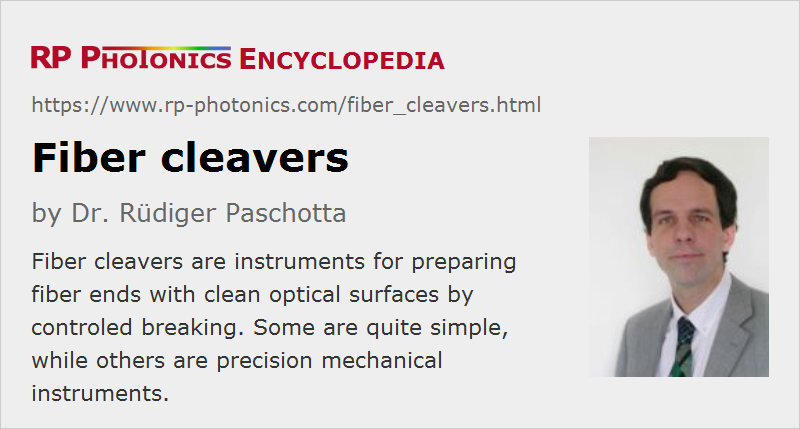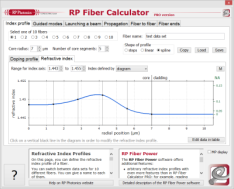Fiber Cleavers
Definition: instruments for preparing fiber ends with clean optical surfaces
German: Faserspalter
Category: fiber optics and waveguides
How to cite the article; suggest additional literature
Author: Dr. Rüdiger Paschotta
In fiber optics, it is often necessary to prepare clean surfaces for optical fibers. This is often done by cleaving, i.e., by controlled breaking. Instruments used for that purpose are called fiber cleavers.
For general aspects of cleaving, such as basic principles, problematic cases and the inspection of cleaving results, see the article on fiber cleavers.
Simple Cleaving Blades
The simplest cleaving method uses only a diamond blade, incorporated into a pen-shaped scribe, with which one manually makes a tiny scratch on the fiber, in a direction perpendicular to the fiber axis. (Note that too strong scratching can spoil the results.) One then holds the fiber on one end and gives the other part a kick with a finger, so that the cleave occurs. Alternatively, one may pull the fiber. Such techniques require some practicing, and the results are somewhat variable.
Simple and inexpensive mechanical cleavers can be part of fiber termination kits. They produce less consistent results than high-quality precision cleavers, as described below. At least, their use requires more practicing, and normally such devices are applicable only to standard silica fibers.
Precision Fiber Cleavers
Cleaving techniques with more controlled conditions allow for more consistent results. For that purpose, there are special apparatuses, called mechanical precision fiber cleavers, which work as follows:
- The fiber is inserted into the cleaver (after stripping its coating) and fixed, typically with a V groove and two clamps.
- By turning a handle, one then applies a tension, the magnitude of which can often be adjusted (e.g. with a screwdriver). That tension alone is not sufficient to break the fiber.
- With a second handle, one now carefully lets a diamond blade approach the fiber, causing the required scratch. The blade may be made vibrating with a small electromagnet or piezo.
- Finally, the tension is increased so that the fiber breaks.
With some cleavers, the tension during application of the blade is already high enough for the fiber to break.
There are versions of mechanical semi-automatic fiber cleavers which also allow for angle cleaving (see Figure 1), i.e., for preparing fiber ends with some angle against the fiber axis. For that purpose, the fiber is somewhat twisted before it is cleaved. Tentatively, stronger twisting leads to larger cleave angles, but that relation also depends on the tension, and there can be a substantial variation of cleave angles from try to try.

Some precision fiber cleavers are part of fusion splicing apparatuses, as precision cleaving is a prerequisite for successful splicing.
Suppliers
The RP Photonics Buyer's Guide contains 24 suppliers for fiber cleavers.
Questions and Comments from Users
Here you can submit questions and comments. As far as they get accepted by the author, they will appear above this paragraph together with the author’s answer. The author will decide on acceptance based on certain criteria. Essentially, the issue must be of sufficiently broad interest.
Please do not enter personal data here; we would otherwise delete it soon. (See also our privacy declaration.) If you wish to receive personal feedback or consultancy from the author, please contact him e.g. via e-mail.
By submitting the information, you give your consent to the potential publication of your inputs on our website according to our rules. (If you later retract your consent, we will delete those inputs.) As your inputs are first reviewed by the author, they may be published with some delay.
See also: cleaving of fibers, fiber joints, fiber optics
and other articles in the category fiber optics and waveguides
 |














If you like this page, please share the link with your friends and colleagues, e.g. via social media:
These sharing buttons are implemented in a privacy-friendly way!